|
Meetings Past
Meeting Highlights - November 19, 2005
by Mary Jane Dapkus
Near record attendance marked the Chapter 148 meeting held on November 19. To say that mart offerings exceeded expectations in the scope and depth of coverage of the collecting field is an understatement. In addition, many tableholders traditionally mingle "Works in Progress" and exhibit items guaranteed to elicit conversation--if they do not take the viewer's breath entirely away!
Such was the case with an 18th century Viennese bracket clock discovered by a keen-eyed collector several years ago. At the time of purchase, the clock was covered with a decidedly indelicate coat of 20th century enamel. After substantial effort all of the clock's lavish embellishments, including an ebonized oak case, feathery spandrels and complete indications, were revealed intact beneath layers of goo.
Members were offered the rare opportunity to inspect a pre-Porter contract Eli Terry movement. This remarkable object, with its cleated back plate and relatively flat count wheel featured an alarm mechanism Silas Hoadley claimed to have invented--but apparently didn't.
Friends shared one of the year's most triumphant collecting stories with fellow member Chris Brooks. For those who haven't had the pleasure of meeting Chris, he has long been interested in obscure timing devices and is especially fascinated by technical details.
Chris's eyes twinkled as he described a 30-yr. search for a Seth Thomas chronometer made only during 1936 and 1938 known by the model names "Guardian" and "Argos". The clock's movement is a variation of the #10 "work horse" most often encountered in telescopes, seismographs and chart recorders. But beyond that neither Chris nor any one else seemed to know what to expect behind the dial.
Recently Chris spotted a ship's chronometer with a characteristic center sweep second hand with crescent counterbalance on eBay. As luck would have it, he was able to purchase the clock. Its secrets are now revealed.
Between the movement's two large barrels, two wheels secured by a spring do not quite overlay one another. The reason? The mechanism adjusts what would otherwise result in faster and slower portions of a minute. It's called a backlash eliminator.
The very talented and friendly Mel Smith provided members a hands-on training session in making a graver and using a lathe for clock repair applications.
Making a graver involves fine grinding, turning and polishing skills. For example, Mel explained that gravers should not be overheated during grinding.
We learned that using a hand graver is a delicate art that takes a good deal of experience to master. Time spent in learning rewards the practitioner with powerful restoration capabilities.
Beginning gravers need to practice with soft materials starting with brass, then proceed to soft carbon steel before advancing to carbide or blue steel. Since it is desirable to preserve the point of the graver, it is not used until corners, for example of a pivot, need to be cleaned at the end of a cut.
Mel advises left-handed gravers to place the headstock to the right on the lathe. For reference he recommends "How to Use a Watchmakers' Lathe (Part VI)" by Archie Perkins, Horological Times, Vol. 7, No. 2, Feb. 1983, p. 16-26.
Special thanks is due to Mel for an excellent, comprehensive demonstration.
-- Mary Jane Dapkus
* * *
Meeting Highlights - July 16, 2005
by Mary Jane Dapkus
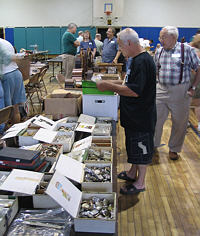 Chapter 148 met on July 16, 2005, a sunny Saturday morning. Mart trading was brisk despite a somewhat lower number of occupied tables compared to recent record-setting levels. Weeklong sultry heat and humidity, however, suggested a possible explanation. Chapter 148 met on July 16, 2005, a sunny Saturday morning. Mart trading was brisk despite a somewhat lower number of occupied tables compared to recent record-setting levels. Weeklong sultry heat and humidity, however, suggested a possible explanation.
We were very glad indeed to learn that Chris Bailey of the American Clock and Watch Museum is rapidly recovering from a recent illness and has returned to work, albeit initially on a part-time basis. Our hearty best wishes are with him!
Members were treated to a most interesting hands-on presentation provided by guest speaker Ian Wetherly. Ian's background is veterinary medicine, and his topic was resilvering antique clock dials.
Much to our entertainment and delight, Ian's approach was basic. After explaining parts, materials and ornamentation of early dials, Ian removed the brass chapter ring fastened by pins to a fine old Dutch example to prepare for resilvering.
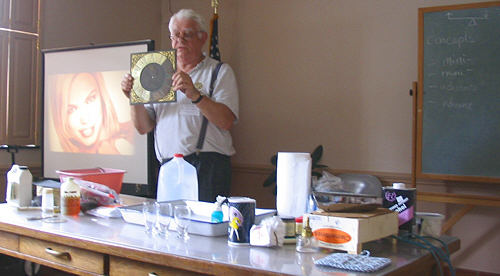
Ian Wetherly, holding the brass dial from an antique Dutch tall clock he used to demonstrate resilvering.
Next Ian explained that clock cleaner or even paint stripper may be applied several times to completely remove tarnish and old varnish from brass chapter rings. As with other clock parts made of brass, care must be taken not to scratch or scrape thereby marring the relatively soft alloy. Undesirable scratches will also show beneath very thin coats of elemental silver.
After removing dirt and varnish, the chapter ring is washed with soap and water, dried and rubbed to a high shine with gradually finer grades of steel wool. As a last resort, a few drops of vinegar, lemon juice or muriatic acid might be used on recalcitrant areas. The dial is then salted prior to applying silver.
Ian dissolved silver nitrate sticks (used to staunch animal bleeding) in distilled water in a kitchen glass. Then he added sodium chloride in the form of ordinary table salt to precipitate the silver. Pouring off the liquid supernatant and rinsing 3-4 times leaves a small amount of thick white silver gel.
After applying the silver with [rubber-gloved] fingertip, the relatively dry silver layer is gently touched with soft gauze dipped in a solution of household cream of tartar mixed with water. This solution brightens the silver coat.
Next the numerals on the chapter ring need to be blackened by pressing in engraver's wax. If any scratches still show it is necessary to apply another layer of silver before applying the wax.
To blacken the numerals, sealing wax or black shellac is first grated to a fine powder with a kitchen grater. A small wooden spatula may be used to apply the wax to the numerals.
To melt the wax Ian adapted an ordinary household flatiron, turning it upside down to heat the chapter ring from the non-silvered underside. (It is necessary to hold the chapter ring with tongs while doing this as it becomes quite hot.) Before cool the wax may be spread using a bit of thin cardboard. Excess wax is removed with denatured alcohol and non-fuzzy shotgun patches (readily available at WalMart and elsewhere.) India ink may be used for touch up.
Finally, Ian recommends applying a coat of acrylic floor wax to keep the silver from tarnishing and to give an appropriate matte finish. As with other of Ian's methods, this one may sound homespun but the underlying chemistry is sophisticated: using clear shellac at this point would dissolve the black engraver's wax! Next, if the acrylic wax finish appears bubbly, use Dawn dish detergent to remove or correct. If the resulting finish appears whitish, or to prevent white marks when touched by fingertips, let the chapter ring dry 24 hrs. before applying a coat of car wax such as Turtle Wax.
Ian concluded by providing an elegant introduction to the concepts involved in gold electroplating.
We are most grateful to both Ian and Mrs. Wetherly for cordially sharing their experience, knowledge and kitchen utensils for the purpose of this presentation. We hope you will return to visit often!
-- Mary Jane Dapkus
* * *
Meeting Highlights - May 21, 2005
by Mary Jane Dapkus
On a sunny Saturday May 21, 2005, Chapter members reconvened at the Edmond Town Hall. Although there were few empty tables, attendance appeared somewhat reduced from previous record levels. Nonetheless, we were pleased to meet new member Paul Carlson of East Haddam, CT.
Our chapter was deeply disturbed to learn that Chris Bailey, the American Clock and Watch Museum's esteemed curator, is seriously ill. In addition to many years caring for the Bristol, CT institution's collection, Chris's achievements as a writer and researcher in the field of horology are well-known, widely read and greatly appreciated. Equally important (but perhaps less well-known) are Chris's works in the field of genealogy. However, aside from his scholarly pursuits, Chris is simply much beloved for an amiable personality and a warm, generous, patient, hospitable nature. His presence at the museum (to many of us locally like a second home) this season will be sorely missed. We extend our heartiest best wishes to Chris for a speedy, full, comfortable recovery!
Many of our chapter's exceptionally talented, personable members and table holders hail from substantial distances out-of-state. An excellent example is the team of Kathy and Russ Ferris, whose table never fails to elicit amazement, often containing very scarce items gleaned from the vicinity of their Massachusetts home. The May meeting was no exception: objects Kathy and Russ offered included a wonderful antique gallery timepiece case in excellent condition.
Like the Ferrises, Jeffrey Bergman of West Milford, New Jersey specializes in clocks and clock restoration. At the May meeting Jeffrey offered several nicely restored examples including an Ansonia Brass and Copper Company steeple clock with a J.J. Beals, Boston, 1854 over-pasted label.
In-state table holders included keen-eyed David Ewbanks, who typically brings a number of rare and interesting finds such as the little cottage clock with Atkins Clock Co. label spotted at David's table in May.
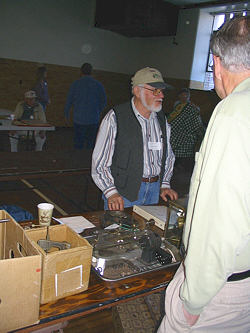 |
|
The skilled and resourceful David Opal, an expert tower clock restorer, presented several lathes including one with a functional cross-piece. David Opal's mechanical background includes advanced training in music box restoration, which he received at the renowned school of Nancy Fratti, formerly located at Whitehall, NY. Although the school no longer exists, it was great fun to hear David explain the special challenges posed by proper maintenance and repair of complex antique music box mechanisms.
Picture: David Opal manning mart table with selection of tools and lathes.
|
Every collector comes to recognize the key to success lies in his library, and David Follett learned that long ago. Indeed David has built a superb library--one with an interesting history in its own right. David's table featured open copies of Eric Bruton's History of Clocks and Watches, and the 1982 (most recent) edition of French Clocks/Clocks the World Over (Part 3), published in Paris by Tardy, to illustrate accompanying items brought for exhibit. Jaws dropped as passers-by noticed a very rare 17th century Dutch hanging clock with prototype pendulum movement; a Timothy Cheney wooden movement with brass dial assembly (ex-Paul Koda collection), an unidentified 8-day wooden tall clock movement (possibly by Benjamin Baniker, Litchfield, CT); and a Mark Leavenworth wooden movement shelf clock with two types of mahogany worked into the case's intricately carved eagle crest.
Picture: David Follett holding an unusual, unidentified wooden tall clock movement.
|
|
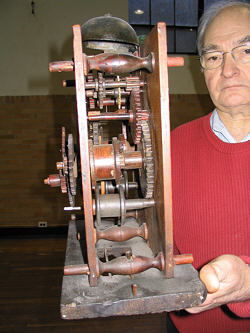 |
Be sure to ask Al and Cheryl Comen about their shared adventures on eBay. And I saw Chris Brown's eyes begin to twinkle as he inspected that chronometer...
Our next meeting promises to feature a lecture and hands-on dial resilvering workshop. Stay tuned!
-- Mary Jane Dapkus
* * *
Meeting Highlights - March 19, 2005
by Mary Jane Dapkus
The Chapter met on Saturday, March 19, 2005. It was wonderful to speak with old friends and new!
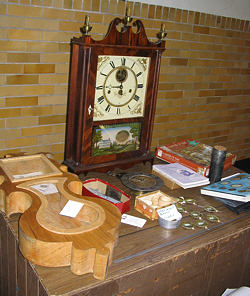 |
|
Meetings continue to grow, not only in terms of the number of members, guests and tables, but also in the breadth and depth of offerings, exhibits and project displays. The following are only a few highlights: Pictured at left are interesting exhibits at the table of George Bruno and David Follett.
Bob Hansen's mart table always generates a lot of interest. The March meeting was no exception. Among many noteworthy finds, Bob brought a wooden movement shelf clock with terrific carving and portions of what appeared to be a Providence, RI label.
Treasures spotted at Tom O'Leary's table included a Waltham 7-jewel octagon watch and a Waltham ladies' pendant watch ca. 1920.
Peggy Blair's table brimmed with useful, hard-to-find tools and books including jewel setting tools, balance screw cutters, a complete set of watchmaker's staking tools, pin vices, angle measuring tools for micro-machining, a Moseley lathe and a couple of depthing tools.
|
Phil Yannone and Harry Blair exhibited a joint restoration project consisting of a very fine French pin-wheel escapement skeleton clock.
Harry discovered the clock in a state of something less than disrepair while on a trip to London a couple of years ago. With 35 years' experience as a foreign auto mechanic, Phil brought micro-machining skills and expertise in antique clock and watch repair to bear on the project. As many members are aware, Harry is an expert watch repairer who also holds both a professional engineer's license and an M.B.A. He is the author of a book on the Bulova Acutron.
Picture: French pin-wheel escapement skeleton clock
Harry Blair and Phil Yannone's restoration project
|
|
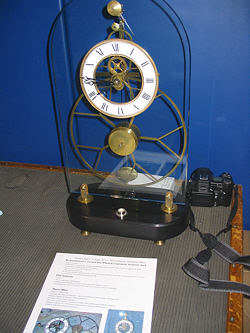 |
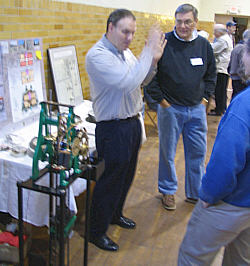 |
|
Chris Locke and Jerry Valenta exhibited their latest joint restoration project, a Seth Thomas tower clock with a patent date of May 28, 1931. The project is part of the ongoing redevelopment of the Fairfield Hills Hospital property. Plans are to reinstall the clock onsite.
The Fairfield Hills tower clock was missing several parts, and many other parts needed to be rebuilt. When discovered, the clock possessed neither motor, table nor switch. The spur gear that winds the weights was damaged. The mercury switch assembly needed substantial overhaul.
In some aspects of the tower clock project, it was possible to refer to existing examples as templates for restoration. Other aspects such as repair of the balance involved some guesswork and experimenting. The balance had to be silver soldered and the weight of the rod accounted for by means of a counterweight.
Picture: Chris Locke (speaking) with Jerry Valenta on his right and the Seth Thomas tower clock.
|
Much of the fun and satisfaction in restoring rare horological items such as the Seth Thomas tower clock and the Edmond Town Hall tower clock (which Jerry and Chris continue to maintain) derives from a network of support and assistance. Thus Jeff Wood of Massachusetts recently came to donate sheet platinum needed to fabricate a replacement contact tip for the Edmond Town Hall clock. Dana Blackwell continues to contribute his wealth of experience and expertise. John Bolton recently donated a movement and parts suitable for use in the Town Hall boiler room slave clock that had remained unrestored until recently.
Jerry and Chris are presently looking for a dial and dial support for another Edmond Town Hall slave clock. In the company of so many astute and resourceful people, we are confident they won't have to wait long to find them.
-- Mary Jane Dapkus
* * *
Meeting Highlights - Jan. 14, 2005
by Mary Jane Dapkus
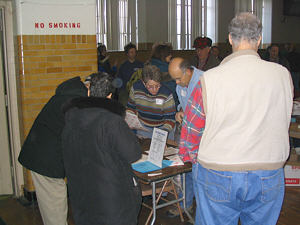
Cheryl Comen & Don Bruno attending the door
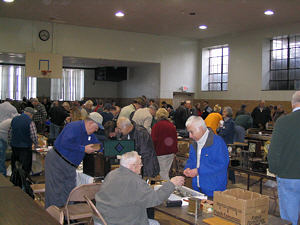
Ch. 148's MART Room
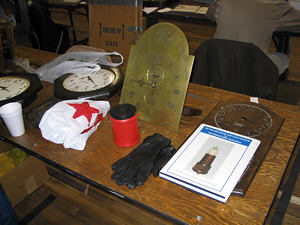
Dial engraved "B. Willard", at table of
David Follett and George Bruno
|
|
Chapter 148 met on Saturday, January 15, 2005. It was not only the chapter's first meeting of the New Year, but also its first under new leadership.
Thanks to everyone who volunteered, members have stepped forward to relieve the Katzin family after a highly successful 7-year stint managing the chapter by assuming the various duties involved. Most notably, thanks is due to the capable and congenial Cheryl Comen for accepting the critical role of membership secretary. She is essentially our new "point person". For those of you who haven't met Cheryl, she is also a keen-eyed collector with a background in art analysis. So please introduce yourself and offer your support, encouragement and -- most importantly -- your assistance!
Our mart continues to attract collectors and table holders both locally and regionally. Among the many attractive buys were paperweight clocks from the 19th and early 20th centuries, a Seth Thomas "Corsia" model shelf clock ca. 1896, a strong selection of 19th century pocket watches, several groups of very appealing and collectible early 20th century wristwatches, porcelain clocks, and an E.N. Welch Mfg. Co. marine lever octagon wall clock with rosewood case and patent date of December 11, 1855.
To the delight of all those they encounter along the way, George Bruno and David Follett occasionally collaborate on research and repair projects. This pair of astute craftsmen/collectors utilized their table to provide an exciting display for educational purposes.
David is researching the influence of an Englishman, John Morris, on Massachusetts tall clocks, with particular focus on the mysterious Benjamin Willard. This inquiry followed David's encounter with an intriguing tall clock dating from about 1770. Its extremely rare movement documents English influence. Nonetheless, the dial is superbly engraved with American motifs, including a turkey and winged cherubs. It is also engraved "B. Willard, Grafton".
David's discoveries will provide updates for future editions of Willard House Museum publications. Like sipping a fine New Year wine, it was a great pleasure to share David's contagious enjoyment, relish and enthusiasm for this project.
Tradition holds that our first meeting of the New Year does not include a speaker. Nevertheless, we look forward to a stimulating list of speakers in 2005 --including an update on a new tower clock project undertaken by Chris Locke, Jerry Valenta and friends. Stay tuned.
-- Mary Jane Dapkus
|
* * *
Meetings In 2004
Meetings In 2003
Meetings In 2002
Meetings In 2001
Meetings In 2000
Meetings In 1999
Meetings In Years 1996 - 1998
|






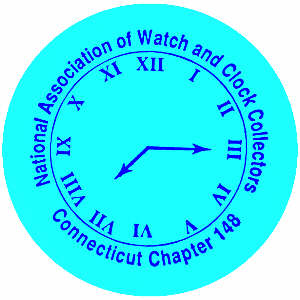
 Chapter 148 met on July 16, 2005, a sunny Saturday morning. Mart trading was brisk despite a somewhat lower number of occupied tables compared to recent record-setting levels. Weeklong sultry heat and humidity, however, suggested a possible explanation.
Chapter 148 met on July 16, 2005, a sunny Saturday morning. Mart trading was brisk despite a somewhat lower number of occupied tables compared to recent record-setting levels. Weeklong sultry heat and humidity, however, suggested a possible explanation.

